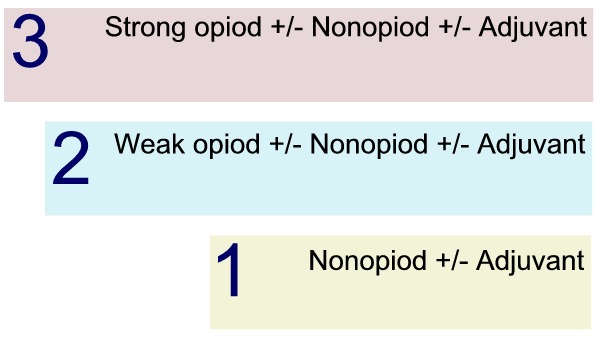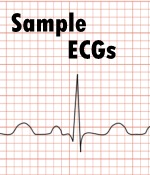To be pain free is the right of every patient and should be the first step of management regardless of the diagnosis. In this post we discuss various pharmacological agents that are commonly used as analgesics.
WHO has coined the term pain ladder which classifies pain according to the severity and helps a clinician to manage pain in a better way. It was originally described for the management of cancer pain, but is now widely used by medical professionals for the management of all types of pain.
The principle is to start from the bottom of the ladder, and to climb the ladder if pain is still present.

Figure showing WHO pain ladder principle for management of pain.
Let us discuss commonly used analgesics –
Non opiods
• Paracetamol: It has a well-known analgesic property and a week anti-inflammatory effect. It is better tolerated in patients in whom excessive gastric acid secretion or prolongation of bleeding time may be a concern. Paracetamol hepatotoxicity the most common cause of acute liver failure in both the United States and the United Kingdom. The common adult dose is 500 mg to 1000 mg. The recommended maximum daily dose, for adults, is 4000 mg.
NSAIDs
• Ibuprofen: Ibuprofen blocks the enzyme that makes prostaglandins (cyclooxygenase), resulting in lower levels of prostaglandins. As a consequence, inflammation, pain and fever are reduced. The usual adult dose is 200 or 400 mg every 4 to 6 hours. Ibuprofen should be taken with meals to prevent stomach upset.
• Diclofenac: Very commonly given analgesic. It is mostly given in acute conditions in an intramuscular form at a dose of 75 mg. Also available as sustained released tablets.
• Aspirin: often used as analgesic to relieve minor aches and pains, as an antipyretic to reduce fever, and as an anti-inflammatory medication.
Weaker opioids
• Tramadol: is a centrally acting synthetic opioid analgesic used in treating severe pain. Like morphine, tramadol binds to receptors in the brain (opioid receptors) that are important for transmitting the sensation of pain from throughout the body to.
• Codeine: is an opiate used for its analgesic, antitussive, and antidiarrheal properties.
Strong opioids
• Morphine: is a potent opiate analgesic medication. Morphine is primarily used to treat both acute and chronic severe pain. It is also used for pain due to myocardial infarction and for labor pains. Common side effects are addiction and constipation.
Adjuvant drugs
• Antidepressants: Antidepressants increase the levels of certain brain chemicals that improve mood and regulate pain signals. Low doses of antidepressants also relieve pain, although it is not known exactly how. Commonly used drugs are Amitriptyline and Imipramine.
• Anticonvulsants: Anticonvulsants control cancer pain by changing the way sodium and calcium travel across the surface of nerve cells in the brain. The nerve cells send fewer signals, and the brain senses less pain. Commonly used drugs are Carbamazapine, Gabapentine and Phenytoin.
• Steroids: Steroids are particularly useful as adjuvant therapy for metastatic bone pain, neuropathic pain, and visceral pain. Dexamethasone is the most commonly prescribed corticosteroid for pain, but prednisone or prednisolone can also be used.
• Muscle relaxants: Muscle relaxants include drugs that reduce muscle spasm (for example benzodiazepines such as diazepam, alprazolam, lorazepam and non-benzodiazepines such as metaxalone or a combination of paracetamol and orphenadrine and drugs that prevent increased muscle tone (baclofen and dantrolene).
• Exercises.
• Psychological support.
• Acupuncture.


The WHO ladder was introduced in 1986 to address the limited availability of opioids for patients suffering nociceptive pain while dying from cancer. The use of the WHO ladder was applied to chronic noncancer pain in a modified fashion and had been a source of many problems. In noncancer chronic pain opioids are of much less value than in cancer pain and much more emphasis must be placed on harm reduction. I strongly advise that you should read the NOUGG guidelines prior to using opioids in chronic non cancer pain.
Posted by Gaylord Wardell | April 27, 2012, 7:42 pmThanks for this valuable information, and due to its side effects like addiction it has become a lot more difficult to prescribe these strong opiods even in India.
Posted by Jaskeerat Singh | April 27, 2012, 9:25 pmhttp://www.who.int/cancer/palliative/painladder/en/
Posted by Prajwal Ghimire | May 4, 2012, 10:32 amAnalgesics are great for reducing inflammation but be advised that it can also cause ulcers. ,.`,*
Thanks again http://www.healthmedicinelab.com“>
Posted by Jean Resides | July 31, 2012, 11:56 am